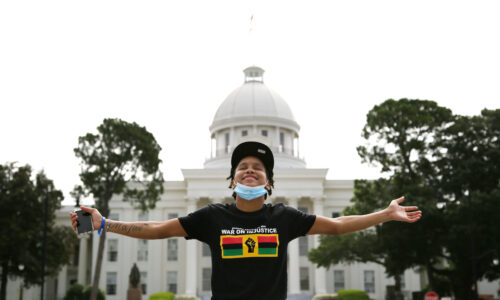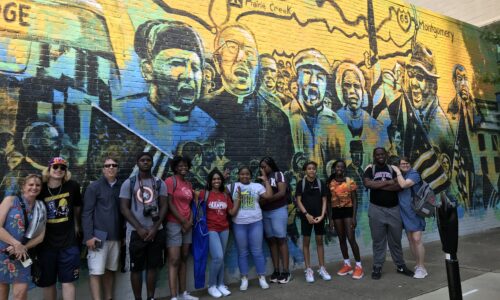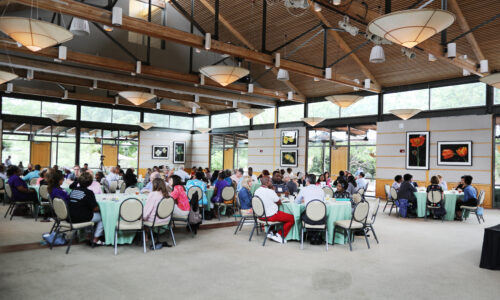

A TRAGEDY REMEMBERED: TULSA CIVIL RIGHTS PILGRIMAGE
February 28, 2023 by Karla Nivens
“My commandment to you is this:
love others as I have loved you.” John 15:12
Interested in joining us for October’s Civil Rights Pilgrimage? Fill out the interest form for the trip here.
As believers, we are called to love God and love our neighbors. Our Justice Ministry’s Civil Rights Pilgrimages play a vital role in HPUMC’s goal to do exactly that. When we embark on these trips, we are friends of God journeying to understand and love others. During the first weekend in February, our Tulsa Civil Rights Pilgrimage brought 20 people from HPUMC to the Greenwood District of Tulsa, Oklahoma. Hearts broke as we learned about and processed painful injustices together. Individuals who took this journey grew personally and spiritually, returning to their daily lives with a new outlook on the importance of loving and understanding others. This is the story of Tulsa.
In the early twentieth century, the Greenwood District of Tulsa was home to one of the most affluent African American communities in history. In fact, it was an all-Black community, and those who called Greenwood home took much pride in their neighborhood, their businesses, their homes, and their churches. This was a place where African Americans could live in safety and peace. The Greenwood District spanned approximately 40 square miles. It contained thriving grocery stores, libraries, theaters, barber shops, schools, hotels, ice cream parlors, shoe shops, airplanes, carriage garages, and more. The Greenwood community earned the name “Black Wall Street” because of its hard-working citizens who built their community themselves: their homes, their churches, and their own businesses.
Although both the Black and White sides of town in Tulsa were prospering, there was great racial unrest between them, and jealousy was brewing. There were whispers on both sides of town about what could potentially happen if the White citizens from the south, fueled by rage, decided to impose some type of punishment on the Black, or north, side of town.
That day arrived when it was reported that 19-year-old Dick Rowland, a Black shoeshine boy, allegedly attacked Sarah Page, a 17-year-old White elevator operator, in the Drexel Building. The accusation was later proven to be false, but Dick Rowland was still arrested. Citizens from the south and north side of the town gathered at the jail. The citizens from the south wanted to make sure punishment was administered, while citizens from the north wanted to prevent the innocent hanging of Dick Rowland. The sheriff asked the citizens to return home, but a gun was still fired, followed by mass chaos.
The result was the Tulsa Race Massacre from May 31 until June 1, 1921. White citizens systematically looted Black citizens' homes, then burned them down. White Tulsans became deputized by local authorities and flew planes above the north side of town, dropping turpentine bombs from above the former Greenwood District. All the homes and businesses were destroyed. Only one church basement survived, along with about 30 Black citizens who were seeking shelter in the church basement.
By the end of the massacre, about 10,000 Black Tulsans were homeless, and anywhere from 75 to 300 people lost their lives. Black Wall Street was completely destroyed. Black Tulsans were forced to live in tents and were not allowed to leave the north side of town unless they possessed a green card, equivalent to a work visa, or if a White person vouched for them. It was one of the worst losses, termination of generational wealth, and embarrassing points in American history. South Tulsa against north Tulsa. White American citizens against Black American citizens. The reality of this time in history was deleted by local authorities from national news. It was not recorded in history and was never spoken of by either Black or White Tulsans.
Today, Tulsans are working toward unity and reconciliation. They are speaking about the Race Massacre. There are several historical sites dedicated to education, learning, and most importantly, reconciliation. You can visit a replica of a typical home during that time, the Mabel E Heritage House on Historical Greenwood. You can stand among the furnishings of the house, learn about the lives of Black Tulsans, and experience the preserved history in the basement of Vernon AME church—home of the church basement that survived the fire. Along with the historical sites on Greenwood, there sit several tracts of land widely known as the “Steps to Nowhere.” This is the most sobering part of Greenwood because it is physical proof of the Tulsa Race Massacre of 1921. You can walk among burned trees, former walls, and fireplaces, and walk up steps that lead to where a beautiful family used to live.
However, today the steps lead to literally Nowhere. That beautiful life lived by the Black family was needlessly stolen and burned down. As you breathe on this land, reality sets within you. However, you can also visit the John Hope Franklin Reconciliation Park. This location leads you to believe that reconciliation is possible, especially among Christians. As people who are committed to the Lord come together to face their issues, understand each other’s views, and move forward together with equity in mind, reconciliation can certainly be achieved. Consider the word of God calling out to us to move toward reconciliation: “If it is possible, as far as it depends on you, live at peace with everyone” (Romans 12:18). What’s within your reach to help bring about unity and reconciliation among the body of Christ? Tulsa is setting an example for us to follow, but the real answers and the follow-through are up to all of us.




